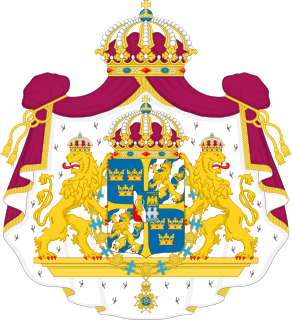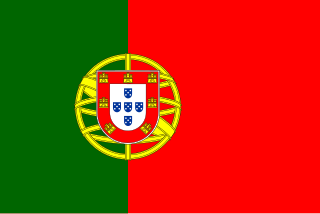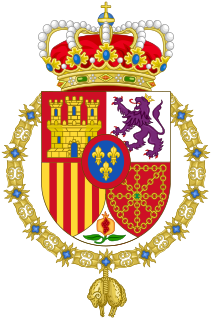
Castile is a territory of imprecise limits located in Spain. Its extension is often ascribed to the sum of the regions of Old Castile and New Castile, as they were formally defined in the 1833 territorial division of Spain. Those two regions cover the following modern autonomous communities: the eastern part of Castile and León, Castile-La Mancha, and Community of Madrid as well as Cantabria and La Rioja. However, it has been pointed out that in practice the modern limits of Castile are imprecise, and that this name has been used mainly as a reference for the image of Spain as a nation.

The coat of arms of the Kingdom of Sweden has a lesser and a greater version.

The flag of Portugal is a rectangular bicolour with a field divided into green on the hoist, and red on the fly. The lesser version of the national coat of arms is centered over the colour boundary at equal distance from the upper and lower edges. On 30 June 1911, less than a year after the downfall of the constitutional monarchy, this design was officially adopted for the new national flag of the First Portuguese Republic, after selection by a special commission whose members included Columbano Bordalo Pinheiro, João Chagas and Abel Botelho.

In heraldry, an escutcheon is a shield that forms the main or focal element in an achievement of arms. The word is used in two related senses. First, as the shield on which a coat of arms is displayed; second, a shield can itself be a charge within a coat of arms.

The coat of arms of Spain represents Spain and the Spanish nation, including its national sovereignty and the country's form of government, a constitutional monarchy. It appears on the flag of Spain and it is used by the Government of Spain, the Cortes Generales, the Constitutional Court, the Supreme Court, and other state institutions. Its design consists of the arms of the medieval kingdoms that would unite to form Spain in the 15th century, the Royal Crown, the arms of the House of Bourbon, the Pillars of Hercules and the Spanish national motto: Plus Ultra. The Monarch, the heir to the throne and some institutions like the Senate, the Council of State and the General Council of the Judiciary have their own variants of the coat of arms.

A Royal Badge for Wales was approved in May 2008. It is based on the arms borne by the thirteenth-century Welsh prince Llywelyn the Great, with the addition of St Edward's Crown atop a continuous scroll which, together with a wreath consisting of the plant emblems of the four countries of the United Kingdom, surrounds the shield. The motto which appears on the scroll, PLEIDIOL WYF I'M GWLAD, is taken from the National Anthem of Wales and is also found on the Welsh designs for £1 coins minted from 1985 until 2000. The badge formerly appeared on the covers of Assembly Measures; since the 2011 referendum, it now appears on the cover of Acts passed by the Senedd and its escutcheon, ribbon and motto are depicted on the Welsh Seal.

The coat of arms of Portugal is the main heraldic insignia of Portugal. The present model was officially adopted on 30 June 1911, along with the present model of the Flag of Portugal. It is based on the coat of arms used by the Portuguese Kingdom since the Middle Ages. The coat of arms of Portugal is popularly referred as the Quinas.

The coat of arms of the King of Spain is the heraldic symbol representing the monarch of Spain. The current version of the monarch's coat of arms was adopted in 2014 but is of much older origin. The arms marshal the arms of the former monarchs of Castile, León, Aragon, and Navarre.

The blazon of the coat of arms of the Princess of Asturias is given by a Royal Decree 979 on 30 October 2015 which was an amendment of the Royal Decree 1511 dated Madrid 21 January 1977, which also created her guidon and her standard.

The coat of arms of Gibraltar was first granted by a Royal Warrant passed in Toledo on 10 July 1502 by Isabella I of Castile during Gibraltar's Spanish period. The arms consists of an escutcheon and features a three-towered red castle under which hangs a golden key.

Portuguese heraldry encompasses the modern and historic traditions of heraldry in Portugal and the Portuguese Empire. Portuguese heraldry is part of the larger Iberian tradition of heraldry, one of the major schools of heraldic tradition, and grants coats of arms to individuals, cities, Portuguese colonies, and other institutions. Heraldry has been practiced in Portugal at least since the 11th century, however it only became standardized and popularized in the 16th century, during the reign of King Manuel I of Portugal, who created the first heraldic ordinances in the country. Like in other Iberian heraldic traditions, the use of quartering and augmentations of honor is highly representative of Portuguese heraldry, but unlike in any other Iberian traditions, the use of heraldic crests is highly popular.

The Spanish autonomous community and province of La Rioja has a coat of arms, which was assigned to the former province of Logroño in 1957, and to the present autonomous community on its foundation in 1982. It consists of a shield which is divided vertically into two halves, featuring respectively the Cross of Saint James and a castle, and is surmounted by a royal crown. Also depicted are Monte Laturce and the Ebro river.

In heraldry and heraldic vexillology, a blazon is a formal description of a coat of arms, flag or similar emblem, from which the reader can reconstruct the appropriate image. The verb to blazon means to create such a description. The visual depiction of a coat of arms or flag has traditionally had considerable latitude in design, but a verbal blazon specifies the essentially distinctive elements. A coat of arms or flag is therefore primarily defined not by a picture but rather by the wording of its blazon. Blazon is also the specialized language in which a blazon is written, and, as a verb, the act of writing such a description. Blazonry is the art, craft or practice of creating a blazon. The language employed in blazonry has its own vocabulary, grammar and syntax, which becomes essential for comprehension when blazoning a complex coat of arms.

The coat of arms of the Extremadura is described in the Title I of the Spanish Law 4 of June 3, 1985, the Law of the coat of arms, flag and regional day of Extremadura.

The coat of arms of the Valencian Community is the official emblem of the self-government institutions of the Valencian Community. It is based on the armorial achievement used from the reign of King Peter IV to John II, called the Great. In 1978 the former Council of the Valencian Country approved it “...for being the oldest known representative emblem of the former Kingdom of Valencia, that had located on the Xerea Gate of the city of Valencia”.

The Coat of arms of the Prince of Spain was set out in the Spanish Decree 814 of 22 April 1971, by which the Rules for Flags, Standards, Guidons, Banners, and Badges were adopted.

The flag of the Region of Murcia was defined in Article 4.1 of the Statute of Autonomy of the Region of Murcia, which established the following:
The flag of the Region of Murcia is rectangular and consists of four castles with battlements or, in the upper left corner, arranged in rows of two, and seven royal crowns in the lower right corner, arranged in four rows, with a pattern of one, three, two, and one, respectively; against a crimson or carmine red background

The flag of Castilla–La Mancha is one of the representative symbols of the Autonomous Community of Castilla–La Mancha, in Spain, defined by its Statute of Autonomy.

The coat of arms of the Castilla–La Mancha is described in the Spanish Law 1 of June 30, 1983, the Law of the coat of arms of Castilla-La Mancha Region and further regulated by Decree 132 of July 5, 1983, approving the official design of the coat of arms of Castilla-La Mancha and Decree 115 of November 12, 1985, supplementing Decree 132/1983.

The coat of arms of Castile was the heraldic emblem of its monarchs. Historian Michel Pastoureau says that the original purpose of heraldic emblems and seals was to facilitate the exercise of power and the identification of the ruler, due to they offered for achieving these aims. These symbols were associated with the kingdom, and eventually also represented the intangible nature of the national sentiment or sense of belonging to a territory.





















